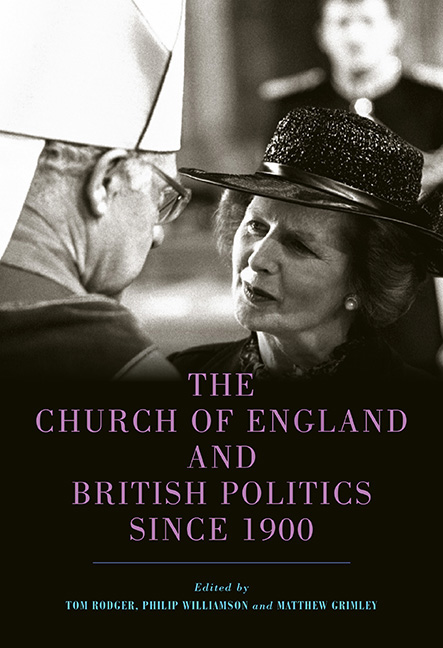Book contents
- Frontmatter
- Contents
- Notes on contributors
- Preface
- Abbreviations and locations of principal collections
- Introduction: the Church of England, the British state and British politics during the twentieth century
- 1 The politics of Church defence: Archbishop Davidson, the national church and the ‘national interest’, c. 1900–14
- 2 Archbishops and the monarchy: leadership in British religion, 1900–2012
- 3 Ecclesiastical conservatism: Hensley Henson and Lord Hugh Cecil on Church, state and nation, c. 1900–40
- 4 Hensley Henson, the prayer book controversy and the conservative case for disestablishment
- 5 Assembling an Anglican view of self-governing sexual citizenship, 1918–45
- 6 Politics in the parish: Joseph Needham at Thaxted, c. 1925–85
- 7 Anglicans, reconstruction and democracy: the Cripps circle, 1939–52
- 8 Parliament and the law of the Church of England, 1943–74
- 9 The Church of England and religious education during the twentieth century 199
- 10 Spiritual authority in a ‘secular age’: the Lords Spiritual, c. 1950–80
- 11 ‘A sort of official duty to reconcile’: Archbishop Fisher, the Church of England and the politics of British decolonization in East and Central Africa
- 12 A ‘baffling task’: Archbishop Fisher and the Suez Crisis
- 13 John Collins, Martin Luther King, Jr, and transnational networks of protest and resistance in the Church of England during the 1960s
- 14 The Church of England, minority religions and the making of communal pluralism
- Index
- STUDIES IN MODERN BRITISH RELIGIOUS HISTORY
9 - The Church of England and religious education during the twentieth century 199
Published online by Cambridge University Press: 28 April 2020
- Frontmatter
- Contents
- Notes on contributors
- Preface
- Abbreviations and locations of principal collections
- Introduction: the Church of England, the British state and British politics during the twentieth century
- 1 The politics of Church defence: Archbishop Davidson, the national church and the ‘national interest’, c. 1900–14
- 2 Archbishops and the monarchy: leadership in British religion, 1900–2012
- 3 Ecclesiastical conservatism: Hensley Henson and Lord Hugh Cecil on Church, state and nation, c. 1900–40
- 4 Hensley Henson, the prayer book controversy and the conservative case for disestablishment
- 5 Assembling an Anglican view of self-governing sexual citizenship, 1918–45
- 6 Politics in the parish: Joseph Needham at Thaxted, c. 1925–85
- 7 Anglicans, reconstruction and democracy: the Cripps circle, 1939–52
- 8 Parliament and the law of the Church of England, 1943–74
- 9 The Church of England and religious education during the twentieth century 199
- 10 Spiritual authority in a ‘secular age’: the Lords Spiritual, c. 1950–80
- 11 ‘A sort of official duty to reconcile’: Archbishop Fisher, the Church of England and the politics of British decolonization in East and Central Africa
- 12 A ‘baffling task’: Archbishop Fisher and the Suez Crisis
- 13 John Collins, Martin Luther King, Jr, and transnational networks of protest and resistance in the Church of England during the 1960s
- 14 The Church of England, minority religions and the making of communal pluralism
- Index
- STUDIES IN MODERN BRITISH RELIGIOUS HISTORY
Summary
This essay considers the Church of England's policy towards religious education in fully maintained schools without a religious character in twentieth- century England and Wales. At first glance, religious education may seem to be a minor aspect of ecclesiastical and political history. Yet it is revealing in several respects. First, the Church has always been committed to the religious education of the whole of the people in England and Wales, not least through schooling. It has consistently taken the view that, as the national Church, it has the cure of all souls, regardless of faith. Such is the Church's commitment to the religious education of all that its attitudes towards schools without a religious character is difficult to distinguish from those towards its own Church schools. Second, policies on religious education may be regarded as a barometer of the dynamic between Church, state, other denominations, other faiths and those of no faith. Education has been an issue on which the Church has always sought to exercise a role in the public sphere, locally as well as nationally, regardless of the population's self-declared religious sensibilities. Third, despite the relentless decline in affiliation, as measured by baptism and confirmation statistics,4 the Church has maintained a significant influence within education. Across the twentieth century the Church has obtained state support and patronage for its schools, with the costs of buildings, repairs and staffing increasingly borne by locally drawn revenues and the national exchequer. In 1903, there were 11,687 Church of England schools educating 2,338,602 children, forming around 40 per cent of the school population. By 2000, the proportion of children educated in the Church's schools had fallen to around 20 per cent, that is 924,000 children. However, in parallel with this decline, the Church negotiated a retention of its direct influence over the nature, purpose and content of religious education in the wider maintained sector. This was chiefly a result of the 1944 Education Act, which required local education authorities (LEAs) to constitute Agreed Syllabus Conferences to prepare, adopt and reconsider syllabuses of religious instruction, and permitted LEAs to constitute Standing Advisory Councils for Religious Education to advise the authority upon relevant matters. The Church has also shaped developments in religious education by means of the financial resources available to it through the Church college trusts, which emerged from the shrinkage in the Church college sector during the 1970s.
- Type
- Chapter
- Information
- The Church of England and British Politics since 1900 , pp. 199 - 221Publisher: Boydell & BrewerPrint publication year: 2020



